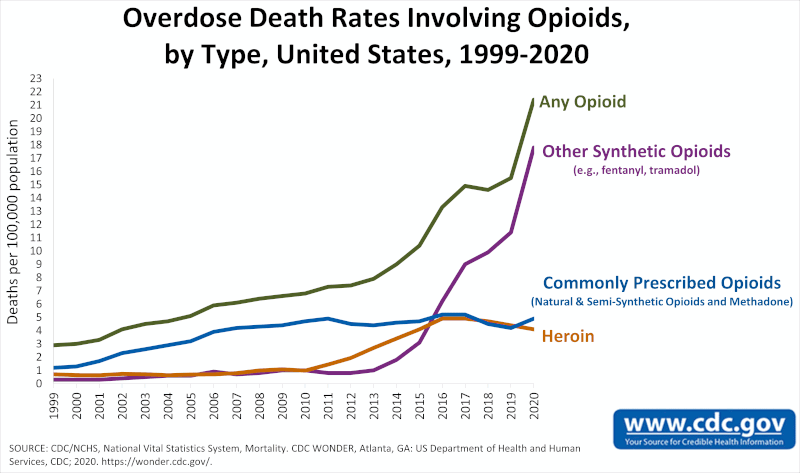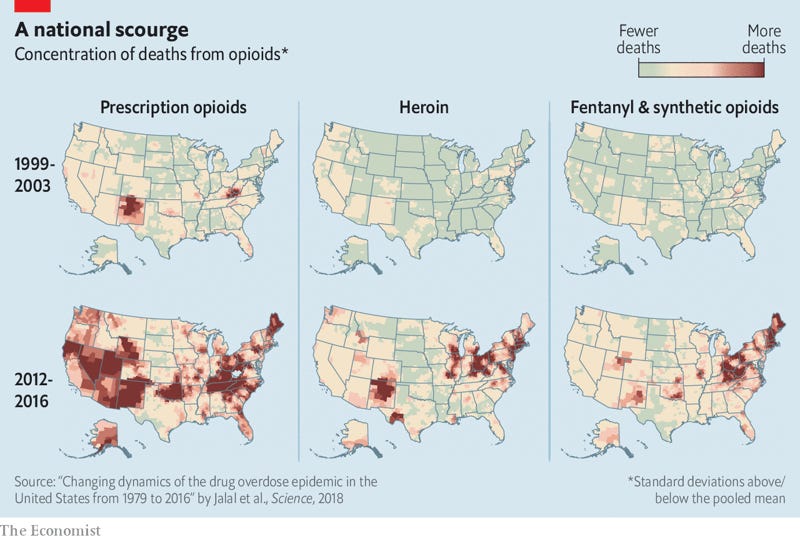Introduction
The current opioid crisis is a major domestic problem in the United States. In recent decades, the rate of opioid overdose deaths in the country has quadrupled. The magnitude and depth of the opioid crisis in the United States is not hyperbolized, although it did not actually happen overnight. The opioid epidemic or opioid crisis is a term that usually refers to the rapid increase in the use of opioid medications in the United States, and this trend did not really begin yesterday but as early as the 1990s. The opioid epidemic developed in three stages. At least today, we say that the opioid crisis had three waves.
The First Wave
The first wave of the opioid crisis arose in 1991 when patient mortality began to skyrocket after a surge in prescriptions for opioid medications (including combination medications). Prescriptions were written for the treatment of even minor and non-chronic pain, and the increase was primarily influenced by assurances from pharmaceutical manufacturers and even medical organizations that the risk of addiction resulting from the use of these drugs was “shallow. Pharmaceutical companies have also begun to promote among physicians the use of opioids in patients with non-cancer pain.
The Second Wave
The second wave of the opioid epidemic began around 2010, by which time the first efforts to reduce prescriptions for opioid drugs began, and addicts switched to the semi-synthetic opioid heroin. As the access to prescription drugs became more difficult, interest in this cheap, affordable, and powerful street drug grew. Heroin use increased dramatically among all demographic and socioeconomic groups: men and women, rich and poor, educated white-collar workers, and people not even out of high school. Heroin overdose deaths increased by 286% between 2002 and 2013. As you can see from the graph on the slide, the number of overdoses from opium increased greatly at that time, which allows you to back up your words with scientific research. The advent of 2013 marked an exponential increase in the number of cases.

The Third Wave
The third wave of the opioid crisis came in 2013, with an increase in deaths related to synthetic opioids (fentanyl, etc.). The sharpest jump came in 2016: more than 20,000 deaths from fentanyl and related drugs. The U.S. Centers for Disease Control and Prevention (CDC) has released new clinical guidelines to optimize the advantages of available pain treatment choices while lowering the danger of addiction. For example, according to the latest revisions of such documents, opioid medications should be preferred as first-line therapy for chronic pain. Opioid medications, on the other hand, should be prescribed only after a careful assessment of pain levels and subsequent regular review of their need.
Official Declaration of War on Opioids
Overall, in three waves, the jump in opioid overdose deaths has been enormous. In 2016, the opioid crisis lowered Americans’ overall life expectancy from 78.7 to 78.6 years. There’s more to come; in 2017, opioids caused 47,600 of 70,200 drug overdose deaths overall. When President Donald Trump took office, he declared a public health emergency over the opioid crisis. Since then, the statistics on non-medical opioid use seem to have begun to show a downward trend. At least that’s what the White House claims – although it admits that it “will take time” for the government to resolve the opioid crisis finally.
The Underlying Causes of the Opioid Crisis
The U.S. government will have to work on all fronts since there are other root causes of the substance abuse epidemic, primarily related to widespread social upheaval. The past few decades have been characterized by rising unemployment, poverty, and economic inequality, along with a deteriorating social safety net. All this has naturally been accompanied by a pervasive sense of isolation and hopelessness. Meanwhile, the U.S. leadership continues to take new measures to tighten drug trafficking, which, in turn, leads to the black market introduction of synthetic (and often lethal) alternatives. The end result of these seemingly disparate processes is what we see today: an increase in overdoses and the development of other diseases of the desperate.
Fighting Addiction
There is now a wide range of medications available in the United States to treat opioid addiction. For instance, the nation has approved medications like buprenorphine and methadone, which function by blocking all or a portion of the opioid receptors. They are authorized to treat withdrawal symptoms and drug cravings. Other available treatments in this area are based on the use of opioid receptor antagonists such as Naltrexone and Naloxone, commonly known as Narcan. In addition, experimental therapies range from the use of psychedelics such as Ibogaine to treat the addiction itself to Cannabidiol (CBD) or vaccines.
Effective medications exist to treat opioid use disorder, but more medications need to be created to overcome the problem of overdose further. According to Dr. Paxton Bach, a clinical assistant professor of medicine at the University of British Columbia Medical School, new tools are sorely needed for professionals working in the field. Bach cites Vancouver as one of the epicenters of Canada’s highly addictive drug overdose crisis and notes that a growing number of patients are proving unresponsive to available treatment options. As a result of opioid addiction research, he says, psychedelics such as Ibogaine or Psilocybin have already been able to demonstrate some potential, though they are in the early stages of development.

Dangerous Psychedelics
The prospects for the use of psychedelics are encouraging to many, but these substances must be carefully studied, experts say. Ibogaine is known to have side effects, including decreased heart rate. Ibogaine can cause patients to have QT interval prolongation, and because of the potential risks, only suitably qualified clinicians should use the drug. Prescribing and dosing psychedelics require determining which patients will benefit from this particular treatment and which will not. “Those who want a one-size-fits-all solution to all situations are forgetting the complex nature of substance use disorders, and they are extremely heterogeneous,” adds Deborah Mash.
At the same time, given these circumstances, alternative developments could have great potential. For example, treatments such as methadone therapy are not available to everyone, and such programs are not offered to the public in rural areas. If new therapies are developed that are not subject to the same strict regulations as Methadone or Buprenorphine, they would have the significant advantage of greater availability and could be used to supplement these already available and effective therapies. Consequently, the search for new medicines is still ongoing. It is important to emphasize not only the already popular medications but also to create alternative methods of solving the problem that do not depend on drugs.
Risks of Experimentation
Many companies are wary of substance abuse projects because they find the field risky. There are perceived risks in the development of a substance abuse treatment, unlike other diseases, partly because patients are from certain demographic groups with particular socioeconomic problems and because of the stigma that comes with addiction. Some companies believe that if they develop a drug in this area, they may lose the return on investment that the companies would have received if they had developed medications for other diseases. On the other hand, experience with opioid addiction drugs, such as those containing buprenorphine/naloxone, which is among the few effective treatments for overdose and addiction, has shown that candidate drugs could be found in this area that could be profitable.
Conclusion
A promising avenue for the development of medications aimed at combating opioid addiction could be for pharma companies to collaborate with universities and other government agencies. Marco Pravetoni, Ph.D., professor in the Department of Psychiatry and Behavioral Sciences at the University of Washington, is currently working on the development of a potential vaccine that targets Oxycodone specifically; it is now in the first phase of clinical trials. However, screening such candidates through preclinical studies and clinical application is not easy; it requires much more staff resources and funding. This graph shows how much opium addiction treatment costs have increased in recent years.

References
Centers for Disease Control and Prevention. (2021). Opioid data analysis and resources | CDC’s Response to the Opioid Overdose Epidemic | CDC. Web.
NBC News. (2020). U.S. Drug war has met none of its goals. NBC News. Web.
The Economist. (2021). Tens of thousands of Americans die each year from opioid overdoses. The Economist. Web.
